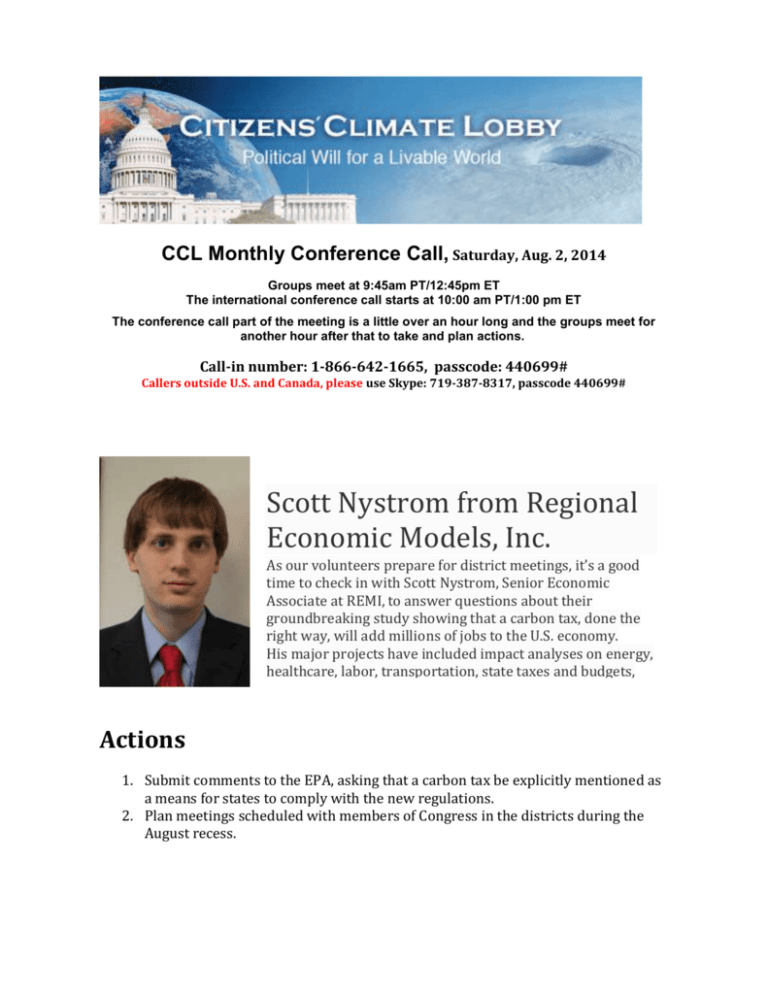CCL Monthly Conference Call, Saturday, Aug. 2, 2014 Groups meet
advertisement

CCL Monthly Conference Call, Saturday, Aug. 2, 2014 Groups meet at 9:45am PT/12:45pm ET The international conference call starts at 10:00 am PT/1:00 pm ET The conference call part of the meeting is a little over an hour long and the groups meet for another hour after that to take and plan actions. Call-in number: 1-866-642-1665, passcode: 440699# Callers outside U.S. and Canada, please use Skype: 719-387-8317, passcode 440699# Scott Nystrom from Regional Economic Models, Inc. As our volunteers prepare for district meetings, it’s a good time to check in with Scott Nystrom, Senior Economic Associate at REMI, to answer questions about their groundbreaking study showing that a carbon tax, done the right way, will add millions of jobs to the U.S. economy. His major projects have included impact analyses on energy, healthcare, labor, transportation, state taxes and budgets, and federal fiscal policy. Actions 1. Submit comments to the EPA, asking that a carbon tax be explicitly mentioned as a means for states to comply with the new regulations. 2. Plan meetings scheduled with members of Congress in the districts during the August recess. LASER TALK Climate change and national security Climate change has serious national security implications. A Deputy Assistant Secretary of Defense has told the U.S. Congress that ongoing climate change will impact all Department operations.1 Naval bases need to be redesigned or relocated because of rising sea levels. Combat readiness is becoming either more costly or more difficult to achieve. Pentagon planners say climate change is a threat multiplier.2 When security specialists survey the global threat matrix, they see flashpoints where conflict is more likely to occur due to the destabilizing impact of ongoing climate disruption. The dislocation of monsoon rains, coupled with the over-pumping of fossil aquifers, has reduced water tables to dangerously low levels where half the world's people live. The disappearance of fresh water stocks from mountain glaciers in the Himalayas and the Hindu Kush is putting the fresh water supply for 3 billion people at risk. Insecurity of food and water supplies threatens to blur borders3 and put unprecedented strain, from human migration, on countries ill-equipped to cope with such crises. Between India, Pakistan and Bangladesh, as many as 500 million people live in climate-vulnerable circumstances that could require sudden migration. The Military Advisory Board of the Center for Naval Analyses reports climate change impacts are already accelerating instability in vulnerable areas of the world, serving as catalysts for conflict.4 If the United States wants to avoid the burden of emergency disaster relief spending, war-fighting on multiple fronts, and major foreign aid initiatives, the mitigation of climate-borne risk must be a priority. 1 "Climate change hits all Pentagon operations, official says". The Hill. URL: http://thehill.com/policy/energy-environment/213027-climate-change-hits-all-pentagon-operations-official-says 2 "Climate Change is a Threat Multiplier".ClimateLiberty. URL: http://www.climateliberty.org/roundtable-report 3 2014 Quadrennial Defense Review. United States Department of Defense. URL: http://www.defense.gov/pubs/2014_Quadrennial_Defense_Review.pdf 4 National Security & the Accelerating Risks of Climate Change. Center for Naval Analyses. URL:http://www.cna.org/sites/default/files/MAB_2014.pdf ACTION Register comments about EPA’s carbon rule This month we ask that volunteers submit comments to the EPA and ask that a carbon tax be explicitly mentioned as a means for states to comply with the new regulations. Ask for specific guidance on implementation, administration, and price points for compliance. The context: In June, the EPA released draft rules limiting the carbon emissions that can come from existing power sources. These existing power sources must cut their emissions to 30% below 2005 levels by 2030. These rules apply only to power sources, so fossil fuels used for anything else (transportation, home heating, etc.) are not affected by this rule. The final rule will be published in June of 2015. Comments are being accepted until Oct. 16, 2014. The EPA is not telling states how to meet the targets. Rather, they are letting states choose how to comply with the rule. Much of the draft rule includes ways that states could be in compliance with the new rule. The EPA focuses on 4 “building blocks” for the best system of emissions reductions: improving efficiency of coal plants, switching to natural gas, increasing renewables, and reducing demand. Conspicuously absent from the 645-page draft rule is any explicit mention of a carbon tax as a compliance mechanism. The closest they come is mentioning a “carbon price,” which is not specific enough, as this may also refer to cap-and-trade. EPA officials have stated in public that a carbon tax is a viable compliance mechanism, but if it is not in print, it is unlikely that states will want to take the risk of not being in compliance. Why submit comments? The EPA is legally obligated to read and respond to all comments. This means that if, for example, you were to include the REMI report as part of your comment, they would be obligated to read it. This is an opportunity to make sure the EPA knows what you know. If enough comments are submitted saying basically the same thing, the EPA will group them together and address them as a group. The more comments there are, the more attention that particular concern is likely to receive. Why does CCL care at all about state level carbon taxes? 1. Because we want Big Business lobbying the federal government for a federal carbon tax. The more states that choose to comply with the EPA regulations via a carbon tax, the more complicated it gets for companies to do business in the US under different carbon pricing regimes. To minimize their compliance costs, and protect their bottom line, they will lobby the Federal Government to step in with a single federal carbon tax. 2. We want data. The more states that employ a carbon tax, the more data we will collect showing how effective carbon taxes are at reducing emissions and their effect on the economy. As powerful as our REMI study is, actual data is always more powerful than a model. How to submit a comment This website lists several ways to leave a comment: http://www2.epa.gov/carbon-pollution-standards/how-comment-clean-power-plan-proposedrule We highlight two: 1. Comment online at: http://www.regulations.gov/#!documentDetail;D=EPA-HQ-OAR2013-0602-0001 Paste the address into your browser, click on the blue “Comment Now!” button at the top right of your screen, and follow the instructions. 2. Submit your comment by mail. Send to this address: Environmental Protection Agency, EPA Docket Center (EPA/DC), Mailcode 28221T, Attention Docket ID No. OAR–2013-0602, 1200 Pennsylvania Avenue, NW., Washington, DC 20460 Your comment can be very simple, or very complex. An example of a simple comment: “Thank you for the work you’re doing to make our world a better place. It is important to me that the final rule for the Clean Power Plan explicitly list a carbon tax as an option for states to comply with the rule. It is also important that guidance be provided to states on implementation and administration of any tax, as well as acceptable dollar amounts and escalation rates. States should have as many options as possible available to them, as long as they are effective in reducing carbon emissions. Thank you.” Background reading If you are interested in including a more technical comment, you can read more about the EPA rule here: https://www.federalregister.gov/articles/2014/06/18/2014-13726/carbonpollution-emission-guidelines-for-existing-stationary-sources-electric-utility-generating#h-49 You can download the REMI at this site: http://citizensclimatelobby.org/wpcontent/uploads/2014/06/REMI-Synapse-Carbon-Fee-and-Dividend-Slide-Deck-6.9.141.pdf You can access the CBO’s assessment concluding a carbon tax is more economically efficient than cap and trade here: http://www.cbo.gov/publication/41663 ACTION Follow up with plans to meet members of Congress Our actions last month were to schedule district meetings with members of Congress during the August recess and to look for opportunities to engage them at town hall meetings and candidate forums. At your meeting this month, discuss and plan the district meetings that have been scheduled. Continue to press for meetings not yet scheduled. Report back on any town hall meetings or candidate forums that may be coming up and discuss strategies for leveraging those events.







